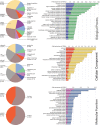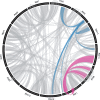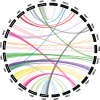The Rhododendron Genome and Chromosomal Organization Provide Insight into Shared Whole-Genome Duplications across the Heath Family (Ericaceae)
- PMID: 31702783
- PMCID: PMC6907397
- DOI: 10.1093/gbe/evz245
The Rhododendron Genome and Chromosomal Organization Provide Insight into Shared Whole-Genome Duplications across the Heath Family (Ericaceae)
Abstract
The genus Rhododendron (Ericaceae), which includes horticulturally important plants such as azaleas, is a highly diverse and widely distributed genus of >1,000 species. Here, we report the chromosome-scale de novo assembly and genome annotation of Rhododendron williamsianum as a basis for continued study of this large genus. We created multiple short fragment genomic libraries, which were assembled using ALLPATHS-LG. This was followed by contiguity preserving transposase sequencing (CPT-seq) and fragScaff scaffolding of a large fragment library, which improved the assembly by decreasing the number of scaffolds and increasing scaffold length. Chromosome-scale scaffolding was performed by proximity-guided assembly (LACHESIS) using chromatin conformation capture (Hi-C) data. Chromosome-scale scaffolding was further refined and linkage groups defined by restriction-site associated DNA (RAD) sequencing of the parents and progeny of a genetic cross. The resulting linkage map confirmed the LACHESIS clustering and ordering of scaffolds onto chromosomes and rectified large-scale inversions. Assessments of the R. williamsianum genome assembly and gene annotation estimate them to be 89% and 79% complete, respectively. Predicted coding sequences from genome annotation were used in syntenic analyses and for generating age distributions of synonymous substitutions/site between paralgous gene pairs, which identified whole-genome duplications (WGDs) in R. williamsianum. We then analyzed other publicly available Ericaceae genomes for shared WGDs. Based on our spatial and temporal analyses of paralogous gene pairs, we find evidence for two shared, ancient WGDs in Rhododendron and Vaccinium (cranberry/blueberry) members that predate the Ericaceae family and, in one case, the Ericales order.
Keywords: chromatin conformation capture (Hi-C); chromosome-scale scaffolding; de novo genome assembly; linkage map; restriction-site associated DNA (RAD) sequencing; synteny.
© The Author(s) 2019. Published by Oxford University Press on behalf of the Society for Molecular Biology and Evolution.
Figures







Similar articles
-
The draft genome assembly of Rhododendron delavayi Franch. var. delavayi.Gigascience. 2017 Oct 1;6(10):1-11. doi: 10.1093/gigascience/gix076. Gigascience. 2017. PMID: 29020749 Free PMC article.
-
Chromosome-level genome assembly of a parent species of widely cultivated azaleas.Nat Commun. 2020 Oct 19;11(1):5269. doi: 10.1038/s41467-020-18771-4. Nat Commun. 2020. PMID: 33077749 Free PMC article.
-
Chromosome-level genome assembly and population genetic analysis of a critically endangered rhododendron provide insights into its conservation.Plant J. 2021 Sep;107(5):1533-1545. doi: 10.1111/tpj.15399. Epub 2021 Jul 17. Plant J. 2021. PMID: 34189793
-
The chromosome-scale genome assembly, annotation and evolution of Rhododendron henanense subsp. lingbaoense.Mol Ecol Resour. 2022 Apr;22(3):988-1001. doi: 10.1111/1755-0998.13529. Epub 2021 Oct 25. Mol Ecol Resour. 2022. PMID: 34652864
-
Hi-C techniques: from genome assemblies to transcription regulation.J Exp Bot. 2024 Sep 11;75(17):5357-5365. doi: 10.1093/jxb/erae085. J Exp Bot. 2024. PMID: 38430521 Review.
Cited by
-
Gapless genome assembly of azalea and multi-omics investigation into divergence between two species with distinct flower color.Hortic Res. 2022 Oct 26;10(1):uhac241. doi: 10.1093/hr/uhac241. eCollection 2023. Hortic Res. 2022. PMID: 36643737 Free PMC article.
-
Genome survey sequencing and identification of genomic SSR markers for Rhododendron micranthum.Biosci Rep. 2020 Jun 26;40(6):BSR20200988. doi: 10.1042/BSR20200988. Biosci Rep. 2020. PMID: 32495827 Free PMC article.
-
Natural hybridization among three Rhododendron species (Ericaceae) revealed by morphological and genomic evidence.BMC Plant Biol. 2021 Nov 11;21(1):529. doi: 10.1186/s12870-021-03312-y. BMC Plant Biol. 2021. PMID: 34763662 Free PMC article.
-
Chromosome-Level Genome Assembly of the American Cranberry (Vaccinium macrocarpon Ait.) and Its Wild Relative Vaccinium microcarpum.Front Plant Sci. 2021 Feb 10;12:633310. doi: 10.3389/fpls.2021.633310. eCollection 2021. Front Plant Sci. 2021. PMID: 33643360 Free PMC article.
-
Whole-genome sequencing and analysis of two azaleas, Rhododendron ripense and Rhododendron kiyosumense.DNA Res. 2021 Sep 13;28(5):dsab010. doi: 10.1093/dnares/dsab010. DNA Res. 2021. PMID: 34289022 Free PMC article.
References
-
- Altschul SF, Gish W, Miller W, Myers EW, Lipman DJ.. 1990. Basic local alignment search tool. J Mol Biol. 215(3):403–410. - PubMed
Publication types
MeSH terms
Substances
Grants and funding
LinkOut - more resources
Full Text Sources
Other Literature Sources

